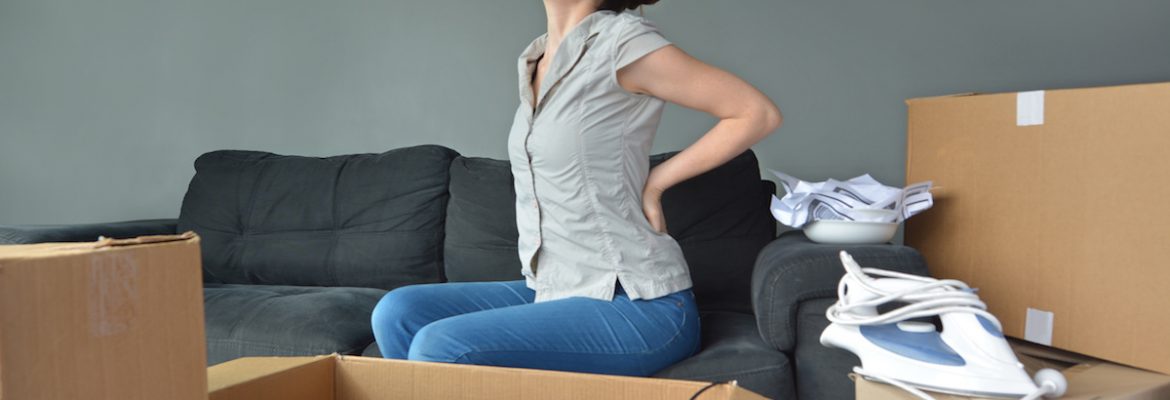
2017-06-13
4 exercises to help you improve herniated disc
If your job requires long-term sitting or standing, if you need to carry heavy objects, climbing up and down the stairs, please be careful! Long-term poor posture and muscle strain can easily lead to spinal problems, and a herniated disc is one of the common conditions. Mishandling of herniated discs can cause an endless amount of troubles and should not be underestimated.
Complex Spinal Nerve Distribution
The human spine is mainly composed of cervical vertebrae, thoracic vertebrae, lumbar vertebrae, with sacral and tail bone with a total of 33 vertebrae. There is a central canal between each vertebra, allowing the central nervous system connected to the brain to pass through the spine to connect the various parts of our body. For example, the cervical vertebrae extend to the hand; the thoracic nerve connects the visceral, lumbar nerves extends all the way to the foot via the sciatic nerve. Thus, the spine is a very complicated design.
In addition to the first and second vertebrae, there is a piece of cartilage between each vertebra, called the intervertebral disc . The outer layer of the intervertebral disc is fibrous tissue, name annular fiber, and the inner layer is soft nucleus, name nucleus pulposus. Nucleus Pulposus has the function of absorbing shock, absorbing the pressure of the spine when the human body is active, and maintaining the normal movement of the spine. With the increase of age, the nucleus pulposus in the intervertebral disc begins to dehydrate and degenerate, and the annulus fiber also has minor tear, which greatly reduces shock absorbing ability of the intervertebral disc . If we still unconsciously make bad postures at this time, the sustained strain of the spine and muscles will inevitably make the disc herniated .
Poor Posture Are The Enemy Of The Spine
When the spinal muscles cannot withstand the pressure of physical activity, it will directly increase the pressure on the disc, so that the internal pressure of the disc will increase, and the intervertebral disc will be easily squeezed out. Sports trauma or accidents are also common causes of disc herniation . Depending on which nerve root that is impinged by the disc, the patient may experience muscle tightness, pain, numbness or pin and needle sensation. The fifth section of the lumbar vertebra and the first section of the sacral bone (L5-S1) is the most affected one, the fourth and fifth sections of the lumbar vertebra (L4-5) is the second most affected one, the third and fourth sections of the lumbar vertebra (L3-4) is the third affected one out of the whole lumbar spine. Regarding to the cervical vertebra, the fifth and sixth section (C5-6) are the most common affected one. Lumbar disc herniation can cause pain in the foot; cervical disc herniation affects the shoulder, back , hand and finger numbness on the patient. In addition, the degeneration of the intervertebral foramen can also affect the severity of the patient’s symptom.
The left picture shows a healthy intervertebral disc; the right picture shows degeneration and thinning of the intervertebral disc, the intervertebral distance is narrowed, and the intervertebral disc is pressed against the spinal nerve.

Left side picture indicate of healthy disc, right side picture indicate of unhealthy disc, the vertebral space is narrower and the disc is degenerated. ( pic 2)
Understanding Intervertebral Disc Metabolism
The intervertebral disc is lack of blood circulation, and it has a natural metabolic method to keep the cartilage healthy. Nutritional entry and waste discharge are important for the intervertebral disc . If the two are out of balance, the problem of insufficient nutrient or excessive waste accumulation will result in dehydration, degradation and tearing of the cartilage will present. Since there are no blood vessels, how does nutrition enter the intervertebral disc ? Nutrition must enter the intervertebral disc through “Diffusion” and it is also necessary to use the “Convection” method to remove waste.
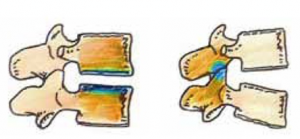
The method of “convection” is to discharge the waste, first straighten the spine and then bend the spine backwards. (pic 1)
When our cartilage is in a weightless state, it will produce an infiltration effect. For example, it is a good way to lie flat on the body. The rehydration will be carried out while we sleep at night. As for convection, when we bend the spine forward, which will push out the liquid in the cartilage, then straighten the spine, and then bend the spine backwards. This can push the liquid into the cartilage. These exercises can be practiced daily.
People nowadays often have wrong postures whenever they are sitting, standing or walking. Over time, the fluid in the cartilage is lost little by little, which leads to an imbalance of cartilage metabolism, and low back pain and neck pain are reported. To have healthy cartilage, cartilage metabolism must be normal, and healthy metabolism requires correct posture and exercise to strengthen cartilage.
4 exercises to improve herniated disc

Exercise 1
Maintaining a squatting position for a few minutes a day can open up the space for the spinal foramen and help the metabolism of the intervertebral disc.
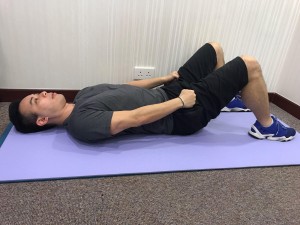
Exercise 2
In the morning and evening, you can exercise for a few minutes on the bed. Hold your fists on your thighs and push forward slowly, and you will feel your spine pushed and stretched.
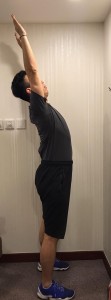
Exercise 3
Raise your hands up as much as possible, and bend your lumbar spine slightly for 6 to 10 seconds, repeat several times a day.
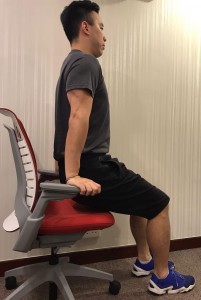
Exercise 4
If there is a chair with armrests in the office (make sure the armrests are stable), hold the armrests with both hands to raise your body, and then keep your body’s center of gravity down for 6 to 10 seconds. Repeat several times a day.

 Book an Appointment
Book an Appointment


